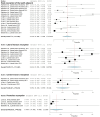CBCT vs panoramic radiography in assessment of impacted upper canine and root resorption of the adjacent teeth: A systematic review and meta-analysis
- PMID: 38496811
- PMCID: PMC10943682
- DOI: 10.4317/jced.61285
CBCT vs panoramic radiography in assessment of impacted upper canine and root resorption of the adjacent teeth: A systematic review and meta-analysis
Abstract
Background: The IC may cause reabsorption of adjacent teeth; therefore detailed assessment of its position would enhance decision-making in the clinical workflow. The objective was to compare cone-beam computed tomography (CBCT) and panoramic radiography (PR) in assessing the position of the impacted upper canine (IC) and root resorption of adjacent teeth.
Material and methods: Pubmed, EMBASE, Science Direct, Web of Science, and SCOPUS databases were searched for studies published before August 2023. Studies that evaluated IC by using both imaging methods were included. For statistical analysis, the Comprehensive Meta-Analysis software (Biostat; Englewood, NJ) was used, p≤0.05.
Results: A total of 17 articles were included, with 877 patients (average age of 17.6 years) and 1,115 ICs. The most frequent mesio-distal location of the IC was in sectors 3 and 4. The meta-analysis was performed with eleven studies. CBCT was more accurate in determining the labio-palatal position compared with PR (p<0.001) (CI 95%; 60% in labial position, 0.254-0.542, OR:0.398; 56% in palatal position, 0.350-0.533, OR:0.441; 78% in mid-alveolus position, 0.188-0.234, OR:0.221). For IC angulation to the midline, CBCT showing a smaller and more accurate angle than PR (p<0.001) (CI 95%, 18.008-33.686). IC angulation to the occlusal plane and lateral incisor, there was smaller angle in PR compared to CBCT (p<0.001) (CI 95%, 51.292-65.934; CI 95%, 30.011-55.954). With PR, fewer cases of root resorption of teeth adjacent to the IC were visualized compared with CBCT (86% less) (p<0.001) (CI 95%, 0.089-0.186; OR value: 0.138; n=1049).
Conclusions: CBCT showed statistically significant differences compared to PR in the assessment of IC position and root resorption of adjacent teeth. CBCT provided clinically relevant information that may contribute to diagnosing and planning IC treatment when PR was not sufficient. Key words:Canine teeth, tooth, impacted, panoramic radiography, Cone-beam computed tomography, systematic review, meta-analysis.
Copyright: © 2024 Medicina Oral S.L.
Conflict of interest statement
Conflicts of interest None declared.
Figures




Similar articles
-
Correlation between panoramic radiography and cone-beam computed tomography in assessing maxillary impacted canines.Angle Orthod. 2018 Jul;88(4):384-389. doi: 10.2319/103117-739.1. Epub 2018 Mar 21. Angle Orthod. 2018. PMID: 29561656 Free PMC article.
-
Effects of impacted maxillary canines on root resorption of lateral incisors : A cone beam computed tomography study.J Orofac Orthop. 2017 May;78(3):233-240. doi: 10.1007/s00056-016-0077-6. J Orofac Orthop. 2017. PMID: 28204849 English.
-
Evaluation of impacted maxillary canine position using panoramic radiography and cone beam computed tomography.Saudi Dent J. 2021 Nov;33(7):738-744. doi: 10.1016/j.sdentj.2020.03.014. Epub 2020 Apr 2. Saudi Dent J. 2021. PMID: 34803328 Free PMC article.
-
Comparison of CBCT and panoramic radiography for the assessment of bone loss and root resorption on the second molar associated with third molar impaction: a systematic review.Dentomaxillofac Radiol. 2022 Mar 1;51(3):20210217. doi: 10.1259/dmfr.20210217. Epub 2021 Sep 14. Dentomaxillofac Radiol. 2022. PMID: 34520245 Free PMC article.
-
Evaluation of Lateral Incisor Resorption Caused by Impacted Maxillary Canines Based on CBCT: A Systematic Review and Meta-Analysis.Children (Basel). 2022 Jul 5;9(7):1006. doi: 10.3390/children9071006. Children (Basel). 2022. PMID: 35883990 Free PMC article. Review.
Cited by
-
A hierarchical deep learning approach for diagnosing impacted canine-induced root resorption via cone-beam computed tomography.BMC Oral Health. 2024 Aug 23;24(1):982. doi: 10.1186/s12903-024-04718-4. BMC Oral Health. 2024. PMID: 39180070 Free PMC article.
-
Evolution of deep learning tooth segmentation from CT/CBCT images: a systematic review and meta-analysis.BMC Oral Health. 2025 May 26;25(1):800. doi: 10.1186/s12903-025-05984-6. BMC Oral Health. 2025. PMID: 40420051 Free PMC article.
-
Evaluation of the Relationship between Impacted Maxillary Canine Teeth and Root Resorption in Adjacent Teeth: A Cross-Sectional Cone Beam Computed Tomography Study.Diagnostics (Basel). 2024 Jul 9;14(14):1470. doi: 10.3390/diagnostics14141470. Diagnostics (Basel). 2024. PMID: 39061607 Free PMC article.
References
-
- Peck S, Peck L, Kataja M. The palatally displaced canine as a dental anomaly of genetic origin. Angle Orthod. 1994;64:249–56. - PubMed
-
- Sarica I, Derindag G, Kurtuldu E, Naralan ME, Caglayan F. A retrospective study: Do all impacted teeth cause pathology? Niger J Clin Pract. 2019;22:527–533. - PubMed
-
- Bjerklin K, Ericson S. How a computerized tomography examination changed the treatment plans of 80 children with retained and ectopically positioned maxillary canines. Angle Orthod. 2006;76:43–51. - PubMed
-
- Chung DD, Weisberg M, Pagala M. Incidence and effects of genetic factors on canine impaction in an isolated Jewish population. Am J Orthod Dentofacial Orthoped. 2011;139:e331–5. - PubMed
Publication types
LinkOut - more resources
Full Text Sources
Research Materials
